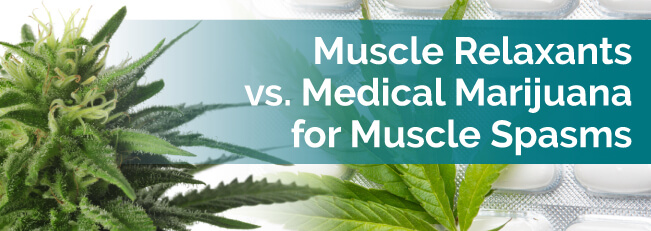
Patients with chronic and/or severe muscle spasms often receive prescriptions for muscle relaxants from their doctors — seems logical enough.
However, you must factor in other issues when you use prescription medicine. Sometimes, you’ll need more prescriptions for your other symptoms and conditions, leading to extra cost and micromanagement. You could also have a bad reaction to the muscle relaxants you and your doctor have access to.
So, like patients with other chronic conditions, some people who have muscle spasms use medical marijuana as an alternative treatment. However, just like any other medicine, you should know about the benefits and drawbacks of it before you use it.
Prescription muscle relaxants come in two categories: antispasmodics and antispastics. Antispasmodics are meant to address muscle spasms, while antispastics treat muscle spasticity. You can’t use antispastics to treat muscle spasms, but you can use antispasmodics to relieve muscle spasticity.
So, as someone with muscle spasms, your doctor will probably recommend using an antispasmodic. Antispasmodic medications include orphenadrine and carisoprodol. Medical professionals advise patients to take these medications only for up to two to three weeks.
The medical marijuana products available to you depend on what your state allows. For instance, some states only approve of cannabis medicine resembling standard medicine, such as pills and topicals. On the other hand, states like California with legal recreational use offer a wide variety of items.
More common medical cannabis products include strains, edibles, concentrates and topicals. While they all have similar benefits, the way they affect you depends on the product type and way you take them.
Both kinds of muscle relaxants have side effects that you should keep in mind. Antispasmodics can cause lowered blood pressure when you stand, reddish or orange urine, headaches, drowsiness, dizziness and nervousness. Antispastics have fatigue, drowsiness, weakness and dizziness as side effects.
But unfortunately, medical marijuana has its drawbacks, too. Some of the more common side effects of cannabis include drowsiness, psychoactive effects, hunger, dry mouth and memory issues. Luckily, you can circumvent most weed side effects by taking your medicine at a different time of day or changing the strain you use.
It’s easy to think prescription muscle relaxants work better than other options because manufacturers engineer them specifically for muscle spasms, but it’s not necessarily true. They may work well enough for some patients dealing with muscle spasms, but research suggests NSAIDs and acetaminophen work just as well without as many side effects.
In addition, prescription muscle relaxants can be habit forming, causing intense withdrawal symptoms when someone suddenly stops taking them. Some patients dealing with withdrawal experience seizures or hallucinations. This means that the margin of error for taking muscle relaxants is low, making them difficult to use.
Marijuana, on the other hand, can provide relief for muscle spasms with less dangerous side effects. The research conducted so far suggests it could provide just as much relief as prescription drugs. Much of it covers its use for MS-related muscle spasms, which indicate that they reduce symptoms.
Since muscle spasms often have an underlying condition, medical cannabis can do double duty for some patients. Besides muscle spasms, marijuana can treat pain, nausea, insomnia and more. Using such a drug allows you to manage fewer medications and worry less about drug interactions.
Using medical marijuana properly requires research, effort and some help from the pros. Visit a medical marijuana doctor or cannabis dispensary today.